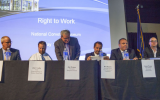Blood and Boots: A History of Union Violence in America

"April 3, 1941, Day two of the first United Auto Workers strike at the Ford Motor Co. factory in Detroit
Part 1: The Lewiston-Auburn Shoe Strike of 1937
Labor bosses claim that they are so “progressive.” Yet the way they achieve their progress is actually quite primitive.
To these bosses, beatings, threats and vandalism can be legitimate tools of workplace negotiation, even as America has evolved to smart phones and satellites.
To give you an idea of the persisting union-related violence since 1975, take a look at some shocking numbers, collected by the National Institute for Labor Relations Research (NILRR):
- 12,000+ incidents of union violence reported by American media
- 203+ American deaths
- 5,800+ incidents of personal injury
- 6,400+ incidents of vandalism
And these are only the incidents that have been reported. And, only since 1975.
In this series, the Center for Worker Freedom will highlight some of the most damaging outbreaks of union violence in American history.
However noble their goals or rhetoric, union bosses have achieved what they have by threatening life and liberty. And we should never forget that.
In fact, the violence committed in the name of American workers often hits hardest on the very people these bosses claim to protect.
The Lewiston-Auburn Shoe Strike of 1937:

The mural depicting the Lewiston-Auburn Shoe Strike
Once upon a time, a mural depicting scenes from the Lewiston-Auburn Shoe Strike of 1937 adorned a wall in the Maine Department of Labor.
After Governor Paul LePage decided to remove the mural in 2011, his opponents filed a lawsuit claiming “censorship.” However, the Governor reminded the agitators that although the mural consisted of 11 hand-made panels, only one side of the strike’s story was portrayed.
In fact, the mural painted the Congress of Industrial Organizations (CIO) as the hero in one of the most violent chapters of Maine’s history, an uprising that destroyed the thriving shoe industries of Lewiston and Auburn in 1937.
The Twin Cities, Auburn (known as “Shoe City”) and Lewiston (known as “Spindle City”), were reliant on their shoe and textile manufacturing industries. Together, the cities were home to 19 shops and more than 8,000 workers produced over 70,000 pairs of shoes a day!
At this rate of production, the city was said to be in its “heyday.” However, organizers from the CIO targeted the area for union establishment, as wages were lower than in Massachusetts. And of course, because there was not yet a union affiliated with the shoe shops.
The union gathered thousands of workers in Lewiston Hall and convinced them to strike. Chaos reigned for more than eight weeks, forcing the government to turn to the National Guard; tear gas was deployed, instigators arrested.

The union called off the strike after realizing that their actions during the hard economic times had destroyed any chance for the manufacturing plants’ business to recover. Consequently, when workers did want to return to work post-strike, most of their jobs were no longer there. The industry had been “permanently injured” and a former striker even confessed that “everybody lost.”
After the strike, the economies of Lewiston and Auburn limped along. The cities were not fully revived until WWII by the surrounding economy and jobs acquired at nearby shipyards.
The mural’s portrayal of the CIO as a hero in these events, which destroyed two local economies, troubled Governor LePage. So, he removed it.
Maine Democrats insisted that this perspective be preserved and served a “bean supper” for $5.00 a ticket where interested viewers could behold a replica of the mural. But dinner organizers denied the event was intended to be political. They really just “wanted to show people what this mural looked like.”
Everyone enjoyed the bean supper according to reports. And everyone had shoes. No thanks to the CIO.





